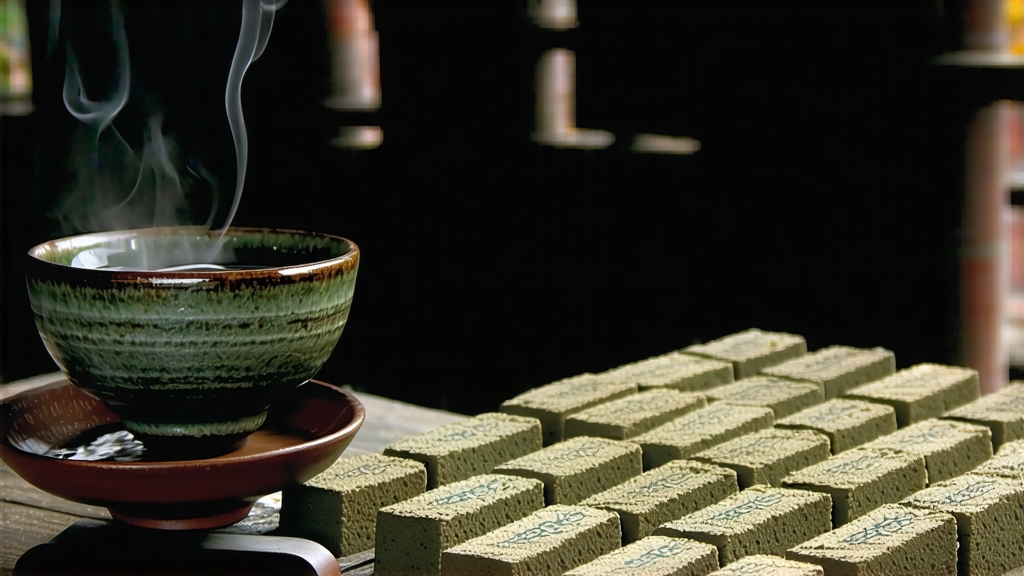
Tucked away in the humid, karst-pocked mountains of southern Guangxi, Liu Bao (literally “Six Forts”) is the quiet cousin of Pu-erh that Chinese tea traders once valued more than silver. While the world now chases the prestige of Yunnan’s ripe cakes, Liu Bao has been quietly fermenting in bamboo baskets since the Qing dynasty, developing a flavor that connoisseurs liken to old Burgundy truffled with betel nut. For the international drinker curious about the deeper end of the dark-tea spectrum, Liu Bao offers a passport to a lost era of river-boat tea markets, medicinal caravans, and cellars that breathe through clay walls.
-
From Ming Garrison to Global Cargo
The name Liu Bao refers to the six stone fortresses built in the late Ming to defend the trade route between Guangxi and Guangdong. By the early Qing, the forts had become tax stations where tea from the neighboring town of Cangwu was weighed, pressed, and loaded onto bamboo rafts that drifted down the Liu-jiang River to the Pearl Delta and, eventually, to Hong Kong and Southeast Asia. Records from 1802 show that Liu Bao was the first Chinese dark tea to be exported in bulk to Malaya, where tin-miners drank it to ward off malaria and dock-workers used it as a digestive after opulent Nonya feasts. The British, busy selling Indian tea back to China, noted in 1886 that “the coolies prefer the black-brick from Kwang-si for its medicinal bitterness.” Thus, long before Pu-erh’s rise, Liu Bao was already the working-class elixir of the South China Sea. -
One Leaf, Two Fermentations
Unlike Pu-erh, which can be divided into raw and ripe, Liu Bao is always “ripe” yet exists on a continuum of post-fermentation. The tea belongs to the large-leaf Camellia sinensis var. assamica that migrated from Yunnan centuries ago, adapting to the red lateritic soils of Guangxi. After spring picking, the leaves undergo:
a. Kill-green at 280 °C for four minutes—longer than green tea, shorter than oolong—to fix a smoky baseline.
b. Rolling while still hot, rupturing 65 % of cell walls to prep for microbial grazing.
c. First sun-drying on bamboo mats until 70 % moisture remains, curling the leaf into a dark jade hook.
d. Wet piling (wo dui) unique to Liu Bao: leaves are sprayed with mountain spring water, stacked 70 cm high, and covered with jute sacks. Thermophilic bacteria (Bacillus subtilis) and molds (Aspergillus niger) bloom, driving the pile to 55 °C within 36 hours. Every two days the pile is turned, aerated, and re-sprayed; the process lasts 25–30 days, twice as long as Pu-erh ripening, yielding a deeper amber liquor.
e. Basket aging: the semi-fermented tea is steamed for 30 seconds, then packed into 40 kg bamboo baskets lined with wild banana leaf. The bamboo breathes, allowing a slow secondary fermentation driven by ambient yeasts (Pichia fermentans) that climb in from the storeroom walls. Traditional caves in the town of Shuangqiao maintain 85 % humidity and 22 °C year-round; here Liu Bao rests for a legal minimum of 18 months, though vintage lots from 1979 still circulate in Hong Kong auction rooms.
-
Tasting the Decades
A 2022 Liu Bao presents a russet liquor with a rim of jade green, an optical trick caused by copper-polyphenol complexes. On the nose you first get damp clay, then a lift of longan and camphor that the Cantonese call “mountain air.” The sip is smooth, slightly betel-nutty, with a returning sweetness (hui gan) that arrives 30 seconds later at the back of the throat. Age thickens the body: a 1998 basket shows prune, tobacco, and a whisper of petrol reminiscent of aged Riesling, while the 1981 “Phoenix label” borders on dark chocolate and Chinese medicine (gan cao and rou gui). The liquor never turns black; even at 40 years it glows like antique mahogany held to candlelight. -
Brewing Like a River Boat Captain